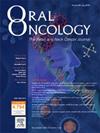患者来源异种移植模型在头颈部软骨肉瘤个体化药物筛选中的应用:一项临床前研究
IF 4
2区 医学
Q1 DENTISTRY, ORAL SURGERY & MEDICINE
引用次数: 0
摘要
目的由于头颈部软骨肉瘤(HNCS)的罕见性,放疗和化疗对其疗效尚未一致确定。患者源性异种移植(Patient-Derived Xenograft, PDX)模型被认为是新药开发和个性化药物筛选的良好临床前模型。本研究旨在探讨PDX模型在HNCS药物筛选中的临床前应用及价值。材料与方法收集我院头颈肿瘤科手术治疗的1例HNCS患者的肿瘤组织。在NCG小鼠中建立PDX模型,并成功传递到裸鼠P3代。肿瘤生长到一定大小后,分别给予三种靶向不同分子的药物(Nilotinib, Regorafenib, Rapamycin)。观察其治疗效果和安全性。结果sncg小鼠是一种能成功建立HNCS PDX模型的小鼠,且PDX模型能在裸鼠体内稳定传递。PDX肿瘤表现出与母体肿瘤相似的组织病理特征。稳定传代后,PDX肿瘤中间充质细胞减少,肿瘤细胞增多,使原代肿瘤细胞更容易提取。在P3 - PDX肿瘤中,口服尼罗替尼和瑞非尼或腹腔注射雷帕霉素可显著减小肿瘤大小。结论对于HNCS等罕见肿瘤,PDX模型是进行个体化药物筛选的良好临床前模型,具有良好的临床应用价值。本文章由计算机程序翻译,如有差异,请以英文原文为准。
Application of patient derived xenograft model in personalized drug screening for chondrosarcoma of head and neck: A preclinical study
Objectives
The effect of radiotherapy and chemotherapy on head and neck chondrosarcoma (HNCS) has not been unanimously determined because of the rarity of HNCS. Patient-Derived Xenograft (PDX) model is considered to be a good preclinical model for new drug development and personalized drug screening. We performed this study to investigate the preclinical application and value of PDX model in drug screening for HNCS.
Materials and methods
Tumor tissues of a patient with HNCS who underwent surgical treatment in the Department of Head and Neck Oncology of our hospital were collected. The PDX model was established in NCG mice and successfully passed to the P3 generation in nude mice. After the tumor grew to a certain size, three drugs targeting different molecules (Nilotinib, Regorafenib, Rapamycin) were given respectively. The treatment efficiency and safety were observed.
Results
NCG mouse is a kind of mouse that can successfully establish the PDX model of HNCS, and the PDX model can be stably passed in nude mice. The PDX tumor show similar histopathological characteristics to the parent tumors. After stable passaging, the mesenchymal cells were reduced and the tumor cells were increased in PDX tumor, making it easier to extract primary tumor cells. In the P3 PDX tumor, oral administration of nilotinib and regorafenib or intraperitoneal injection of rapamycin could significantly reduce the tumor size.
Conclusion
For rare tumors such as HNCS, PDX model is a good preclinical model for personalized drug screening and has good clinical application value.
求助全文
通过发布文献求助,成功后即可免费获取论文全文。
去求助
来源期刊

Oral oncology
医学-牙科与口腔外科
CiteScore
8.70
自引率
10.40%
发文量
505
审稿时长
20 days
期刊介绍:
Oral Oncology is an international interdisciplinary journal which publishes high quality original research, clinical trials and review articles, editorials, and commentaries relating to the etiopathogenesis, epidemiology, prevention, clinical features, diagnosis, treatment and management of patients with neoplasms in the head and neck.
Oral Oncology is of interest to head and neck surgeons, radiation and medical oncologists, maxillo-facial surgeons, oto-rhino-laryngologists, plastic surgeons, pathologists, scientists, oral medical specialists, special care dentists, dental care professionals, general dental practitioners, public health physicians, palliative care physicians, nurses, radiologists, radiographers, dieticians, occupational therapists, speech and language therapists, nutritionists, clinical and health psychologists and counselors, professionals in end of life care, as well as others interested in these fields.
 求助内容:
求助内容: 应助结果提醒方式:
应助结果提醒方式:


